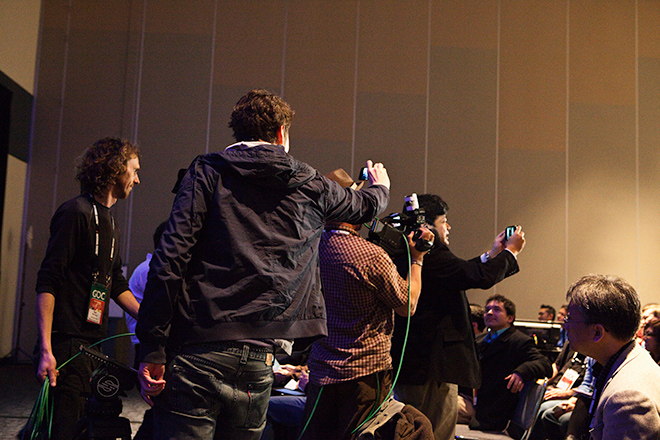
SAN FRANCISCO — Sony is blurring the line between portable game consoles and larger consoles currently trapped inside TV cabinets.
With a high-resolution screen, a powerful processor and graphics card, and massive amounts of memory, the upcoming Sony NGP will be closer to the capabilities of a PC or PS3 than it is to Sony’s current portable, the PSP, according to a Sony executive speaking at the Game Developers Conference Wednesday.
The NGP’s 5-inch screen is substantially bigger than the PSP’s 4.3-inch screen, and has 4 times the resolution, or 960×544 pixels. That’s about midway between the PSP and the PS3, according to David Coombes, a platform designer for Sony Computer Entertainment America.
“People get choked up, they get tears in their eyes when they see that screen,” said Coombes.
Inside, there’s a 4-core, 32-bit ARM9 processor.
There’s also a PowerVR SGX543MP4+ GPU inside, which should deliver impressive video rendering. This is also a multi-core chip with the ability to dynamically load balance between its cores.
The NGP also includes some dedicated chips for media playback.
“It’s very similar to a modern PC” in terms of its processing power, said Coombes. And while Coombes wouldn’t state specifics about memory, he said it’s closer to the PS3 than to the PSP in terms of available RAM.
Games can be loaded via game cards with a capacity of either 2GB or 4GB, giving developers lots of room to create huge, complicated software and datasets.
A big NGP game will take about 4GB, compared to around 9GB for a PS3 game. By contrast, Coombes said, a typical iPhone game occupies only 10MB. The point is that an NGP game can include a lot more data, making it potentially far more complicated, with richer graphics, more detailed and larger worlds, and so forth.
For big games, developers will be able to reuse a lot of assets from existing Xbox or PS3 games, Coombes said, although naturally models, shaders and textures will have to be simplified for the NGP.
A demo of Uncharted for the NGP showed a rich, complicated environment and a variety of ways to control the little man on the screen, from using the analog controls and buttons to swiping on-screen to make him climb from handhold to handhold or to throw enemies into the abysses below. (See below for video.)
Other features included in the NGP include a second analog stick, plus a 3-axis accelerometer and a 3-axis gyroscope, for 6 axes of motion sensitivity.
There’s a touchscreen on the front and also on the back, which you can manipulate with the fingers you’re using to hold the NGP. Both touchscreens support multitouch, and can register how hard you are pressing them as well. A quick demo with a developer from BigBig studios showed the rear touchscreen being used to deform a cartoon landscape to roll a ball around, while touching the front touchscreen changed the camera angle and position.
Like nearly every other portable device hitting the market this year, the NGP has a camera on the front and one on the back. The cameras are meant for game play, said Coombes.
“We need high frame rate, so we can get sharper images” for fast-moving game play. So the cameras are optimized for high-speed, low-light video, not for taking pictures.
Wi-Fi-only and 3G/Wi-Fi models will be available, although the final configurations are not yet settled. The 3G models will also include GPS support, although the Wi-Fi models can also do positioning via Skyhook Wireless, which uses data about Wi-Fi hotspot locations to get relatively accurate location information.
Originally published on Wired: Sony Touts Console-Like Power of Upcoming NGP | GameLife | Wired.com.